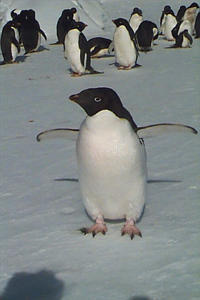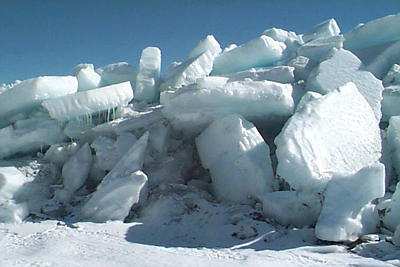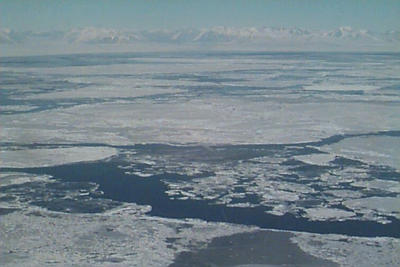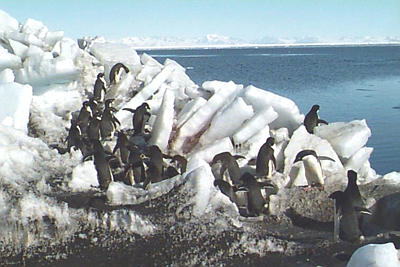25 November, 1998
Wednesday 11/25/98
PENGUINS! Today was a fabulous day full of Adelie Penguins. We
flew north by helicopter along the base of Mt Erebus to an area called
Cape Bird where we wanted to fish from the ice edge. When the ice
melts, microorganisms and algae that grow on the bottom of the ice are
released into the water and this feeds zooplankton which attracts fish
and other predators like orcas (killer whales), penguins, and seals.
We didn't catch a single fish and we didn't see any orcas, leopard
seals, or Emperor Penguins, but we did have a great time with Adelie
Penguins whose massive colonies of thousands of birds we saw as we
flew in by helicopter.
After we were dropped off by the helicopter we went up to the
"kiwi" (New Zealand) penguin research station to get permission from
the scientists there to do our fishing, but no one was home. So we
decided to bring our gear over to the edge of the ice in a place that
would not bother the penguins coming to and from their nesting
colonies. To get to the edge of the sea was no easy task. The sea
ice had been broken into blue and white blocks of varying sizes,
shapes, and textures, and shoved by the wind and sea into a wall over
which we had to lug our coolers, traps, other fishing gear, and camera
gear. Some of the blocks had frozen into place and others were loose.
All was covered with a light layer of sparkling powdery snow so we
never knew when we put our feet down if the block we were stepping on
would hold solid or if our feet would slide on its angled surface.
Sierra stepped on what looked like a solid block which gave way and
her leg went down waist deep into a beautiful chamber of ice blocks.
I slipped on angled blocks, banged my knee, and dropped my camera, but
all was okay.
Once at the ice edge it was great to plop our fishing lines and
baited trap into the sea and to just sit and admire the scenery. The
dark blue, almost black water was motionless. Behind us on the other
side of the ice-block wall we could hear the snuffling of a Weddell
seal as it enlarged its ice hole to pull itself out onto the ice.
Soon he was sound asleep and breathing heavily in the sun. In front
of us, for as far as the eye could see, the sea was covered with
masses of floating ice of varying sizes and shapes. Beyond it, way in
the distance, could be seen the TransAntarctic Mountains, gleaming
white in the sun and dwarfed by the huge expanse of baby blue sky.
Skuas flew back and forth scanning the water for food and on one of
the distant ice floes could be seen a whole line of Adelie Penguins.
Soon these Adelies dived into the water and porpoised towards us,
leaping in and out of the water. What a sight! They looked like
neither bird, nor flying fish, nor porpoise, but at the same time like
all of them! They disappeared and we got back to our fishing and
scenic photography. All of sudden we were startled by a splash as a
penguin shot out of the water and popped onto the ice between Dr Smith
and Sierra! He was soon followed by two others. We all stood around
looking at each other curiously and then the penguins clambered up
over the ice wall seeming to have almost as trouble as we had,
slipping, sliding, bouncing, jumping, despite their large, grip-padded
feet and strong nails. Surely, I thought, we would never get as good a
view as this ever again. I was wrong. All day long, wherever we went
we saw penguins, and they sometimes came up to us so close that I
couldn't focus my camera. Once I tried to get up to move away from one
of them so I could photograph him but every time I sat down, he came
so close to me that I could almost reach out and touch him. Most of
the pictures I shot with my regular slide-film camera but I have
included a few digital photos for you here on this journal page.
While we were fishing I scanned back and forth over and over
searching for new birds and mammals like leopard seals, orcas, emperor
penguins, and snow petrels but saw none. People say it is not the
right time of year to see the birds away from their nesting colonies.
One never knows where a whale or leopard seal will turn up, but the
Adelies always seemed to think there might be one lurking under the
water ready to lunge up and grab one of them. It was comical to watch
a line of cute little Adelies on an ice wall ready to jump into the
water, wanting to go out fishing or bathing. They would stand
nervously at the edge peering down into the water then backing off and
walking away, then walking back again and looking out. No one wanted
to be the first one in just in case. (It reminded me of the
wildebeests trying to cross the Mara River in Kenya, nervous about
possible unseen crocodiles lurking in the murky water to grab hold of
their legs as they crossed.) Finally one of them got his nerve up and
jumped in and they all jumped in almost on top of him like a stampede,
and away they went, zipping around underwater like torpedos or fish,
flapping their wing flippers as if they were flying underwater.
During the day we saw many interesting things about Adelie
Penguins. Here are some of things we saw:
1. Thousands of birds sitting on their eggs in large nesting colonies.
Many of them were lying down on their bellies on their nests. Others
were standing up. Some were reaching out and aggressively pecking at
their neighbors who were doing the same to them. Others were doing
their skypointing display, facing each other, stretching their necks
pointing their open beaks high into the sky while slowly waving their
flippers back and forth and making a growling noise.
2. We had to stay far way from the colony so we wouldn't disturb their
behavior. If they were to leave their eggs in fright, the skuas who
were almost constantly flying overhead looking for an unattended egg
would swoop down, remove the egg, and leave a bewildered and possibly
bereaved penguin behind. We saw one dive-bombing skua fended off by a
few beak-jabs from nearby penguins, but we saw another skua
successfully glide in, remove an egg, and share it with its mate a
mere 15 feet away from the group of Adelies from whom he stole it.
3. One pair of neighbors was having an all-out fight. Over and over
they butted their chests together (like Hans and Franz) and then
started hitting each other with their stubby wing flippers. The sound
of the wing-whacking and the accompanying growling of the excited duo
was quite loud and all the nearby penguins watched with interest and
pecked at the offenders when they came near. I don't know what the
fight was all about. I wonder if one of the birds had lost an egg to a
skua and was trying to take over another bird's egg. I have heard of
such things happening before.
4. Where do penguins get their fresh drinking water? I am sure they
get a lot of the moisture they need from the krill and fish that they
eat, but they also get thirsty while incubating their eggs. As soon
as one incubating bird was relieved by its mate, it went straight to a
nearby patch of snow, lay down on its belly, and ate several mouthfuls
of cool, thirst-quenching snow. Aaaahhhhh....what a relief. I saw
several penguins stisfying their thirst this way.
4. Behind the wall of ice blocks shoved up by the sea, there was a
nice spot in the sun sheltered from the wind. I sat in this sheltered
spot while a parade of penguins waddled to this nice cozy retreat and
soaked in some rays, preened their dense waterproof feathers, snoozed,
and generally loafed around. The birds came up to me, curiously
looked at me, and then waddled past to enjoy their siesta. This was
so amazing that it almost seems like a dream when I think back on it.
5. I often saw large groups of penguins walking long distances along
the shore over the snow and wondered why they weren't swimming in the
water instead. It is much easier for them to move in the water than
on the land. Any ideas of why they might choose the land over the
water? (Another Question to Think About.)
It was quite an amazing day. Today and yesterday were probably
two of the best wildlife experiences of my life.
INTERESTING INFO ABOUT ADELIES
Like the Weddell Seals I described yesterday, the breeding season
of the Adelies must be crammed into a short period of good weather,
little sea ice, and abundance of food. The Yellow-eyed Penguin which
I told you about while I was in New Zealand is about the same size as
an Adelie but its chick takes 14 weeks to become independent of its
parents. The Adelie however must grow up quickly and is ready to
leave home at 6 weeks of age. To nourish that growth the parents
become chick-feeding machines, feeding nearly 1 pound of krill (or
small fish) to its baby each day, sometimes more. A study was done at
nearby Cape Crozier to figure out how much that colony of 175,000
pairs of penguins feeds to their chicks each season. I'll let you do
the math to figure it out: if
175,000 chicks are fed .6 pounds (average) of krill 40 times in the
breeding season how many tons of food did they get?
If the chicks converted that food into 875 tons of new chick growth
what % efficiency is that? Why didn't it all go into growth? Where
did the rest of it go?
If each feeding contained 5000-10,000 krill, how many total krill
did it take to raise this colony of chicks over the breeding season?
One of the reason why people study Adelie Penguins is to give an
idea of the health of the food web of the area. You can see from the
above calculations that Adelies eat an awful lot of krill, a
shrimp-like crustacean which eats microscopic phytoplankton and
zooplankton. It is a major part of the Antarctic food web which most
larger animals including fish, seals, penguins, and whales depend on.
These other animals are much harder to keep track of than penguins are
since most of them live out in the open ocean underwater and don't
breed in big easily-studied colonies. If the population of Adelies is
healthy that is a good indication that the ecosystem must be healthy
too.
One of the concerns of ecologists is the overfishing of krill. Big
ships use a pump to suck up massive numbers of krill which often occur
in huge swarms a kilometer long, so dense that they turn the water a
reddish color. Krill is a good source of protein and vitamin A. Since
krill occurs in patches rather than being evenly distributed
throughout the ocean, it is hard to know how much krill there is. If
we are not careful this important component of the food web could be
overfished. If so what would happen to the rest of the food web?
In my rush to finish things up I don't have time to do a
web-search for you, but Australia has an excellent website about the
Adelie Monitoring program at their Mawson Base. If any of you can do
the search and find this site's http address, I'd appreciate it if you
could send it to me to share with the other readers. On this website
they show some excellent photos of Adelies and also describe some of
the scientific studies being done on Adelies by Autralians. In one of
these studies the researchers put radio monitors on the penguins to
keep track of how deep they dive for food and how far they go to find
food. The site shows some interesting graphs and maps compiling these
data as well as a photo of a device they use to weigh the Adelies as
they go to and from the colony.
Adelies can dive as deep as 100 feet in search of food and sometimes
travel more than 150 kilometers in their quest for food for their
chicks.
How do penguins keep warm in this icy world? They have lots of
blubber to insulate them and to provide energy which they need to
generate heat. They have dense, waterproof feathers which are
excellent insulators even in the wind and water. Their feet and
flippers have a special arrangement of blood vessels (called the
counter-current heat-exchange system) in which the warm blood leaving
the body warms up the cold blood returning to the body. Pretty nifty,
eh?!
Well, I'd better go get back to my other job, counting and
measuring cells.
See ya
I hope you have a good day and do something good for someone.
Fred Atwood
_________________________________________________________
DO YOU YAHOO!?
Get your free @yahoo.com address at http://mail.yahoo.com

This Adelie Penguin was too close for my other camera to focus on so I used the digital. Isn't he a cutey?

A group of Adelie Penguins loaf in the sun protected from the wind by a wall of ice blocks piled up by the sea.

The wall of ice blocks we had to climb over at Cape Bird to get to our fishing spot.

A view from the helicopter on the way to Cape Bird. It is summer and the sea ice is breaking up here at the northern end of Ross Island.

A group of Adelie Penguins at Cape Bird nervously peers into the water from the safety of an ice wall to check for their predator the leopard seal before jumping in.
Contact the TEA in the field at
.
If you cannot connect through your browser, copy the
TEA's e-mail address in the "To:" line of
your favorite e-mail package.
|
